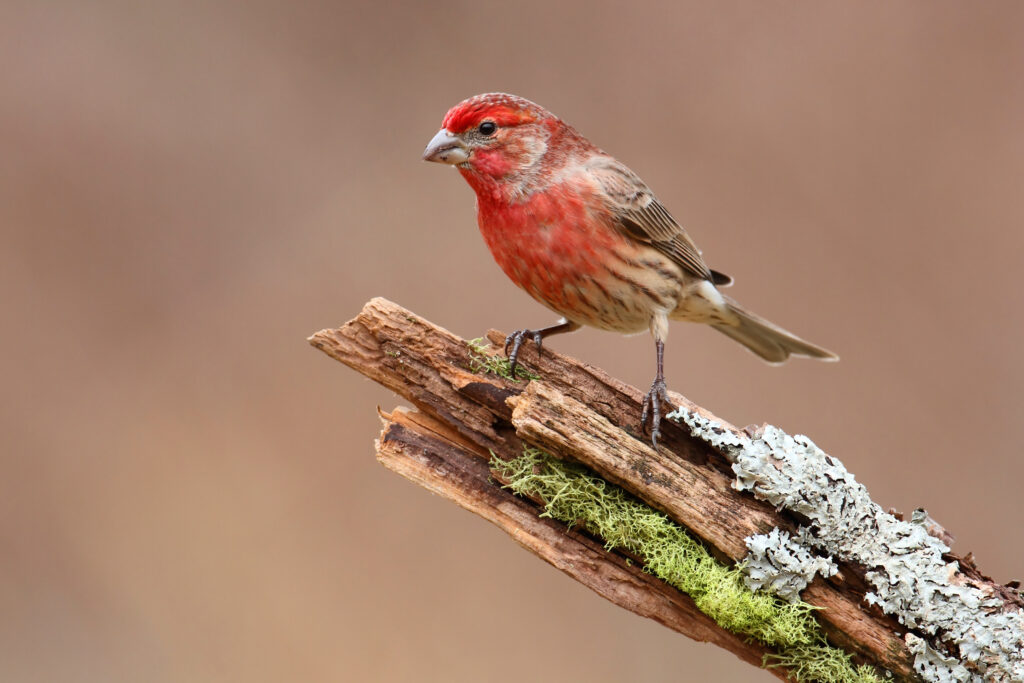Most people know Iowa as the Hawkeye State, and some may recognize it as the leading corn-producing state in the country.
If you’re more interested in fun activities, you probably identify Iowa as the host of the most famous state fair in the country, the Iowa State Fair.
For bird watchers, Iowa is heaven on earth, housing 430 different species, although forests cover only 8.4% of it. Around 145 species breed in the state, while the rest occasionally visit according to their migrating schedule.
Here, we’ll highlight the most common bird species that you’re likely to come across in Iowa.
Red Birds in Iowa
Northern Cardinal
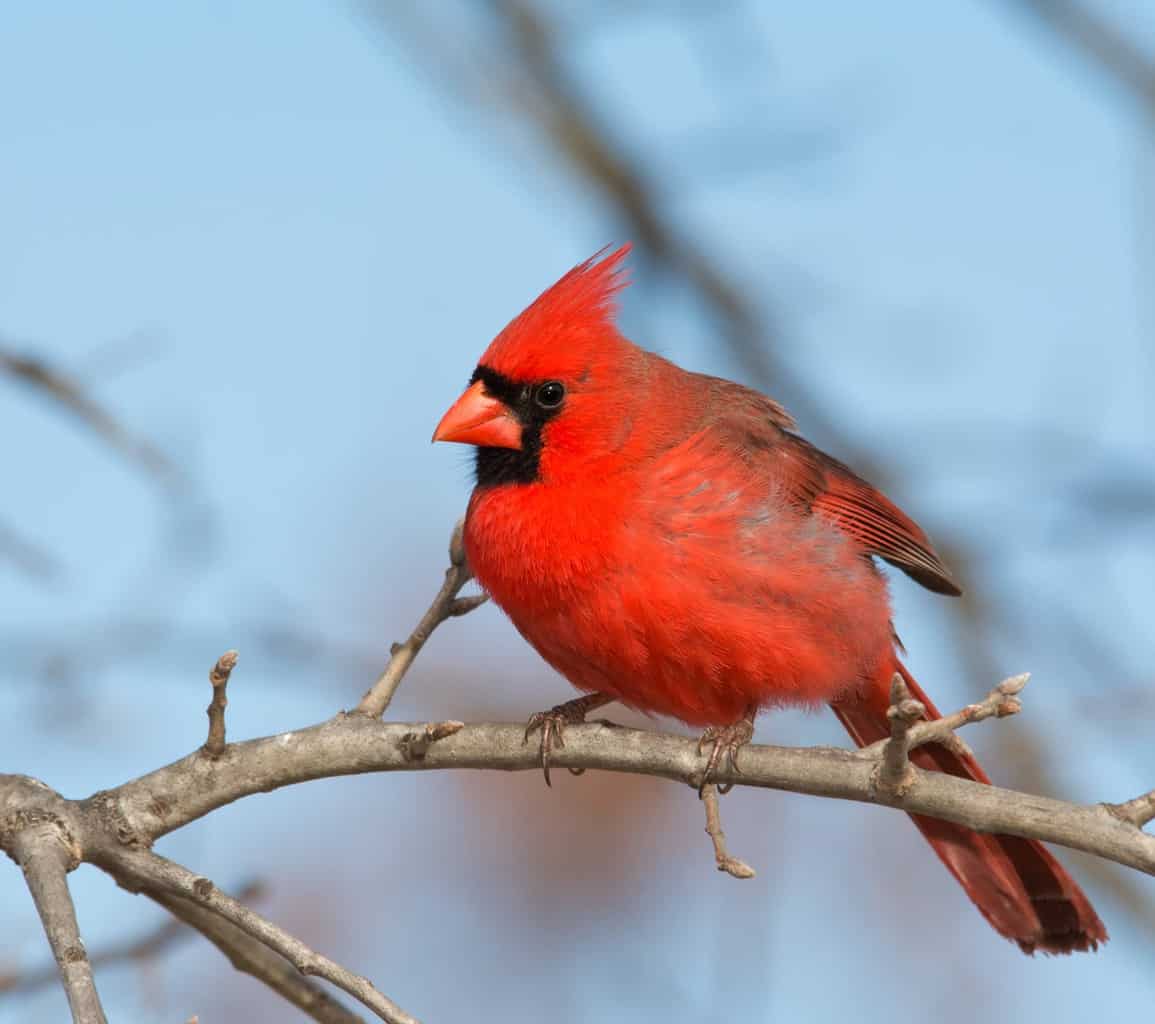
- Scientific Name: Cardinalis cardinalis
- Length: 8.3–9.1 inches
- Weight: 1.5–1.7 ounces
- Wingspan: 9.8–12.2 inches
Northern Cardinals are best known for their vibrant red bodies and their thick bills. You can easily distinguish a male from a female because the females have pale brown bodies, with tinges of red all over. Meanwhile, males have red all over their bodies.
These red types of native birds are most commonly found on trees and low shrubs, and they sometimes forage near the ground. You’ll mostly find them in pairs, and they may visit your bird feeder once in a while.
Your chances of sighting Northern Cardinals are better in inhabited areas, including parks and backyards. They may also spend some time near shrubby forests. They nest in dense vines and shrubs, so seeing their twig nest will be a challenging mission.
Red-Bellied Woodpecker
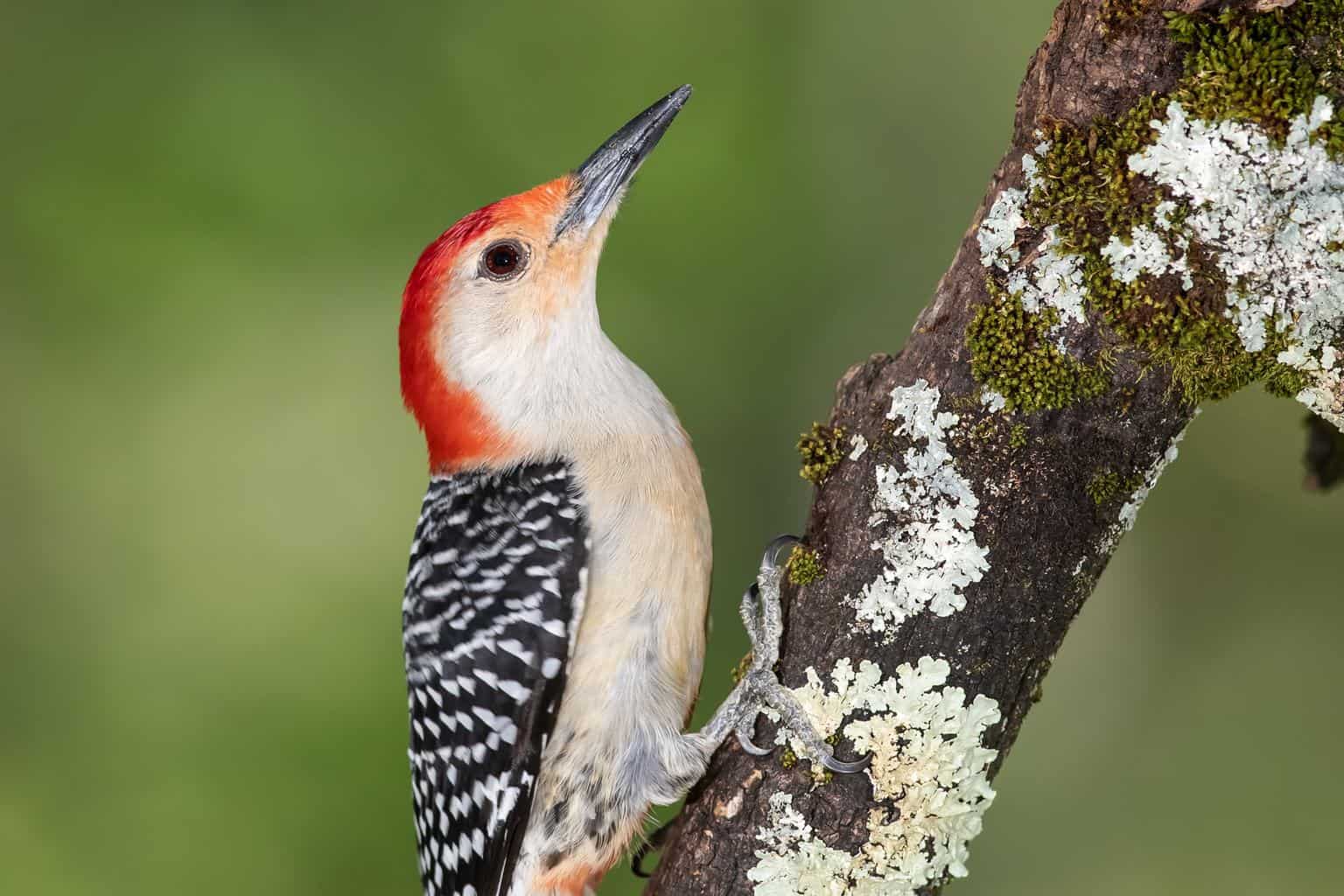
- Scientific Name: Melanerpes carolinus
- Length: 9.4 inches
- Weight: 2–3.2 ounces
- Wingspan: 13–16.5 inches
Red-bellied Woodpeckers don’t live up to their name. Although they do have red in their bodies, their bellies are mostly pale.
They’re called that because they tend to blush a lot around their bellies, but the only red in their bodies is on top of their heads.
Their black wings are also embossed with a distinctive white pattern, so you’ll identify them in an instant.
These beautiful birds are known for sticking to their territory, not leaving unless they’re migrating. That goes for the whole year. That’s why they tend to store their food in the warm summer months to survive through the winter.
Red-bellied Woodpeckers visit backyards a lot. If you want to attract them, you may lay peanuts and sunflower seeds around. They mostly nest in dead trees, so you may search for those too.
House Finch
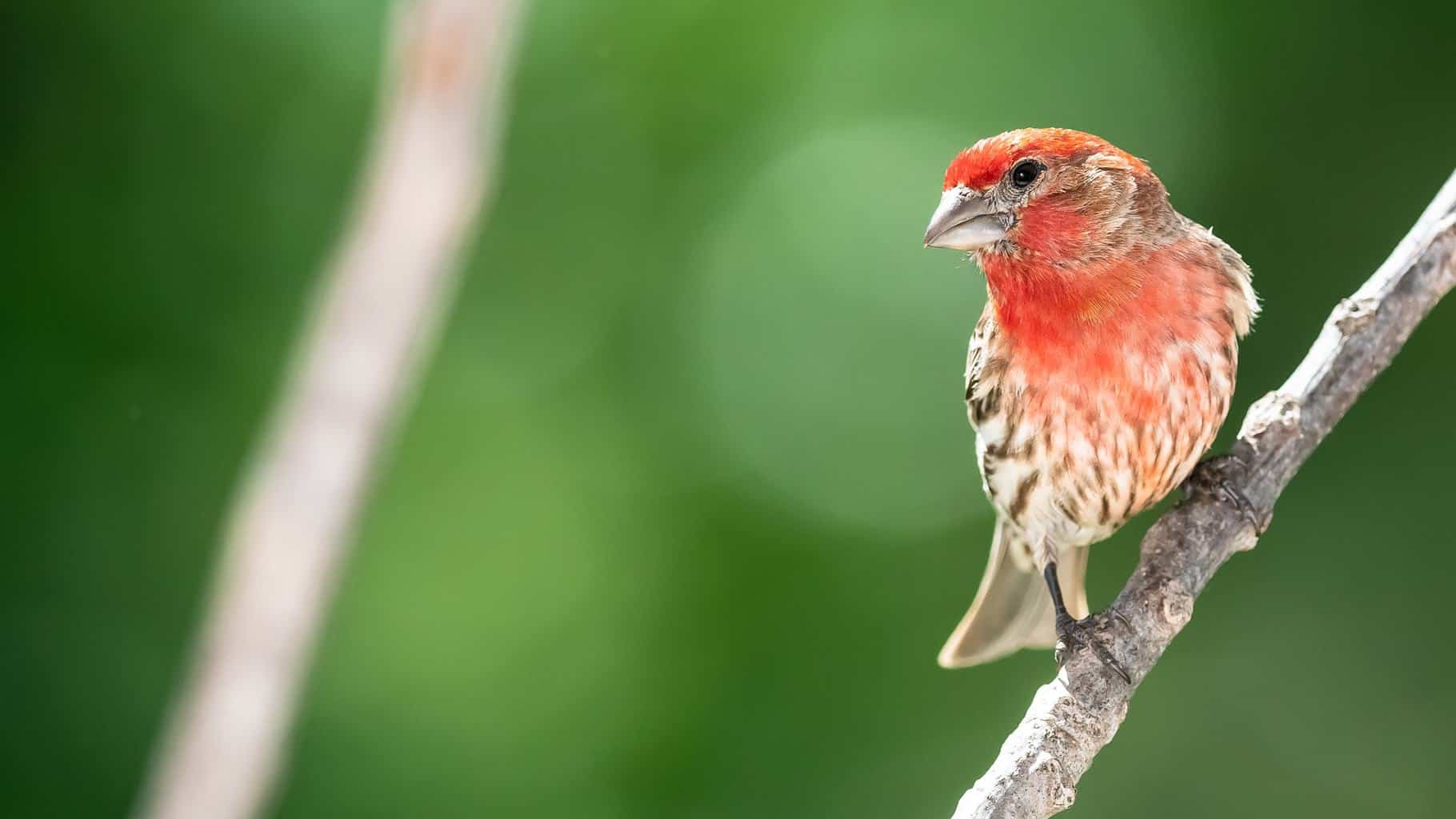
- Scientific Name: Haemorhous mexicanus
- Length: 5–6 inches
- Weight: 0.6–0.9 ounces
- Wingspan: 8–10 inches
House Finches are a bit tricky to identify by their color because the females aren’t red, but brown color. They have brownish-gray bodies without any hints of red. The males are red, though, so you can look for those instead.
They have red upper chests and faces, and some birds have red all over their bodies. It depends on the diet. Male finches also have short wings, making their tails seem longer than usual.
Finches are gregarious, meaning they live in flocks. They are also common backyard birds. They go around backyard feeders in small groups, twittering their way inside. If you want to attract them, lay some sunflower seeds in the feeder, and they’ll come instantly.
When House finches aren’t at backyard feeders, they’re perching in high trees or searching for food close to the ground. They look bouncy when flying, as all finches do.
Red-Winged Blackbird

- Scientific Name: Agelaius phoeniceus
- Length: 9–10 inches
- Weight: 2.5–3 ounces
- Wingspan: 12–16 inches
The Red-winged Blackbird is one of the most abundant species in Iowa. If you live in the state, you’ve surely encountered one or two before.
Although their bodies aren’t totally red, male blackbirds have vibrant red shoulder badges that can be identified in an instant. The striking contrast between the two colors is easy to catch from a far distance.
Red-winged Blackbirds will do anything to get noticed, although they already get enough attention because of their bodies. They’ll perch on high trees and sing all day long in a scene that’s hard to miss.
In winter, the blackbirds gather in large flocks and move around collecting food. They’ll eat grains, seeds, and other blackbird species.
You’ll likely find these popular birds along saltwater and fresh marshes, and they frequently stay around a standing supply of water on golf courses. You may also find them in old fields and meadows.
Blue Birds in Iowa
Blue Jay

- Scientific Name: Cyanocitta cristata
- Length: 9–12 inches
- Weight: 2.5–3.5 ounces
- Wingspan: 13–17 inches
Blue Jays are pretty common in all of the states, so you’ve undoubtedly seen them once or twice in your lifetime. You’re lucky if you did; they’re among the most beautiful birds in the world.
They have blue feathers for plumage, with some unique fellows having lavender bodies instead. The blue color is around their backs, crests, tails, and wings, so they’re easy to identify.
Blue Jays are best known for their love for acorns. If you want to find them, search for oak trees, and you’ll likely find them there. Luckily for you, Iowa has twelve different oak species native to it, so your mission won’t be hard.
If you want to attract them to your backyard feeder instead, you can fill it with suet, peanuts, and sunflower seeds.
Despite their small bodies, Blue Jays have a call that sounds like that of a hawk. They use it to warn their fellow Blue Jays of impending danger, like prey birds around their territory.
Indigo Bunting
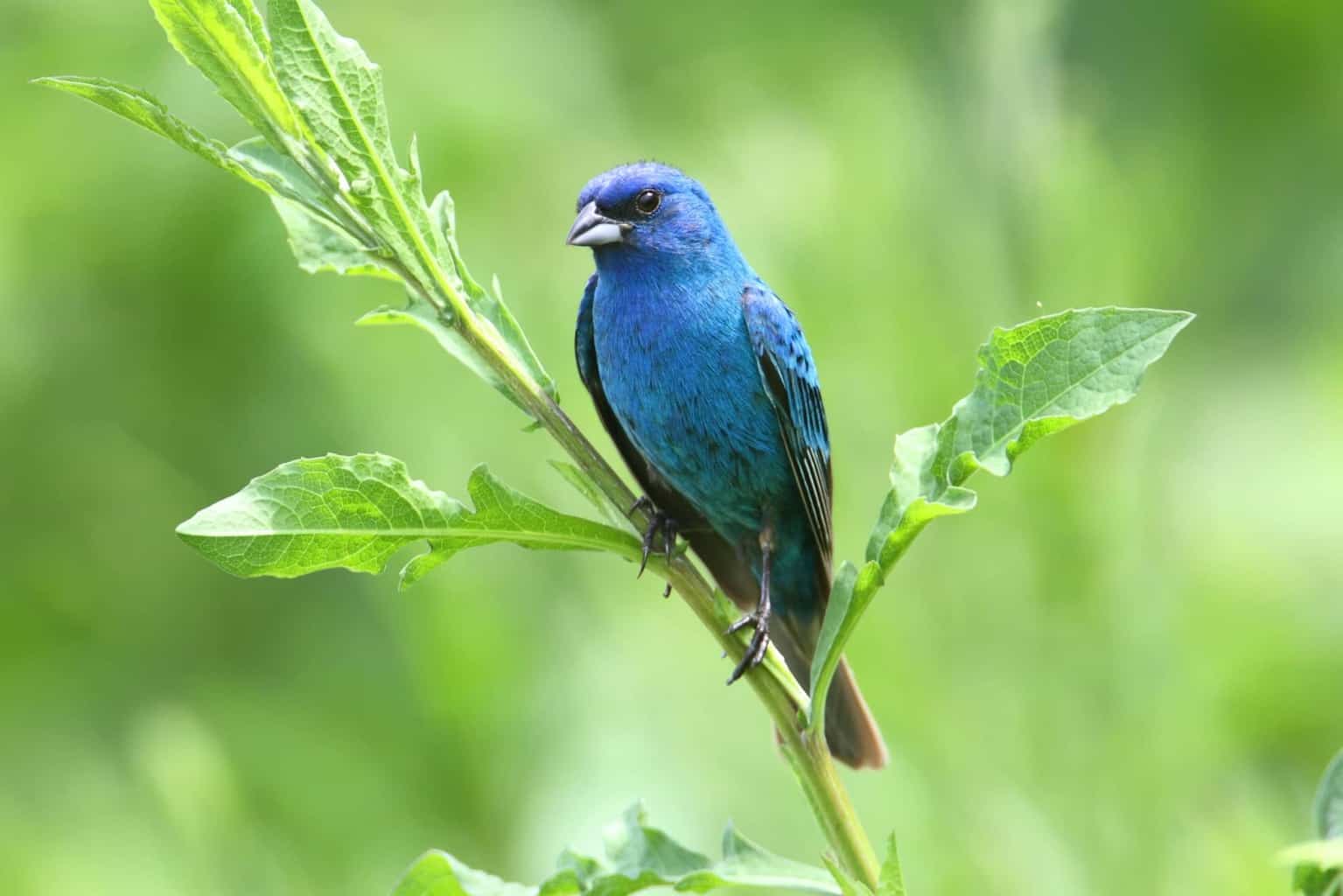
- Scientific Name: Passerina cyanea
- Length: 4.5–5.9 inches
- Weight: about 0.5 ounces
- Wingspan: 7–9 inches
Indigo Buntings are bluer than most bluebirds in Iowa. Their bodies are bright blue all over, and their heads are colored in a deeper shade.
The only part of their body that’s not blue is the tip of their wings. They have black tips, but they’re surrounded by blue all over, so they’re not that noticeable.
Buntings have small, stocky bodies, and they mostly spend their time on telephone lines, singing their hearts out.
They arrive in Iowa in early May, and they stay in the state until mid–September. If you search for them in that window, you have a high chance of catching sight of them.
You may find Indigo Buntings in areas with a lot of weeds and bushes. They like to hide in overgrown patches. Additionally, they may visit your feeder if you offer them small seeds, like mealworms and thistles.
Pinyon Jay
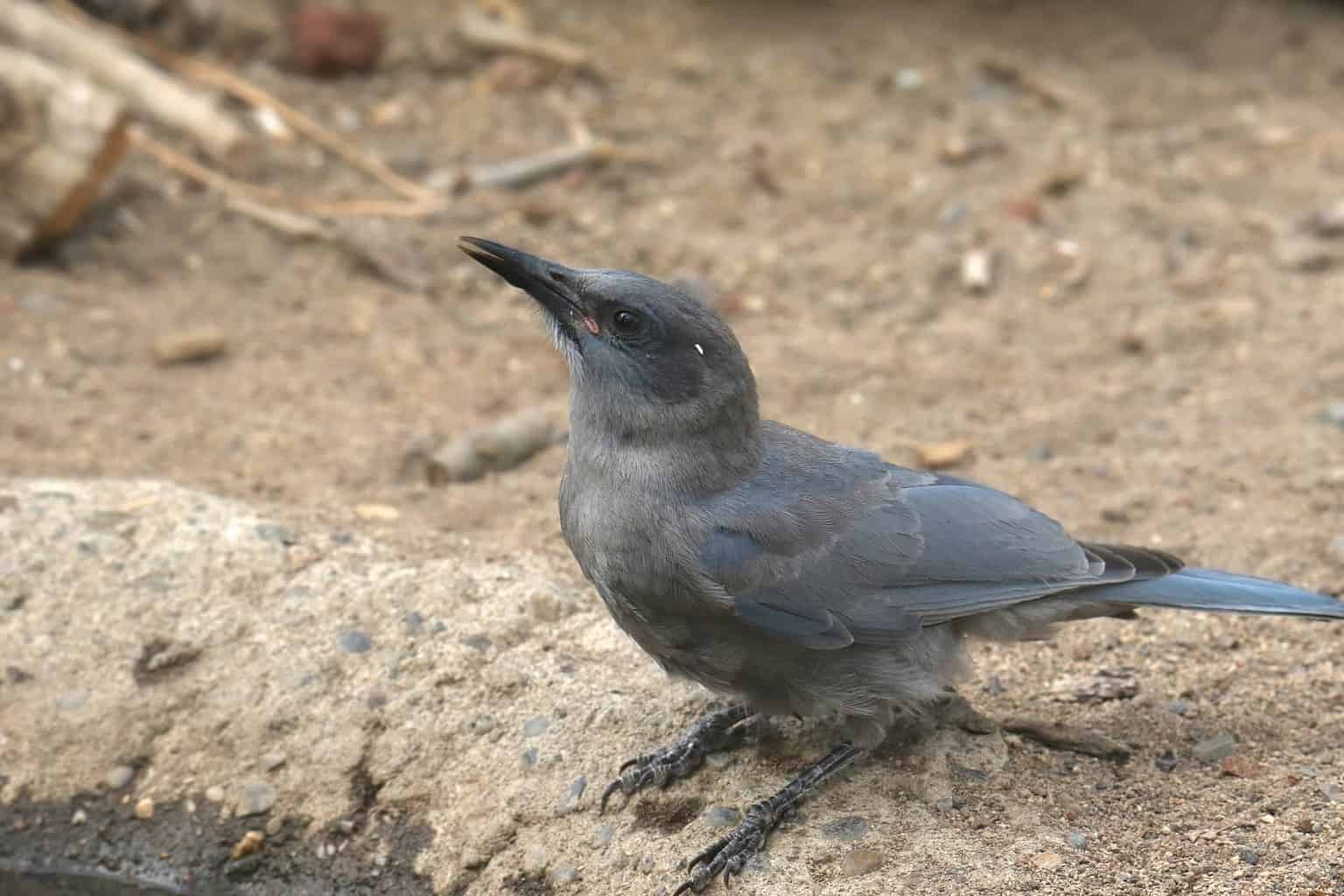
- Scientific Name: Gymnorhinus cyanocephalus
- Length: 9–11 inches
- Weight: 3.2–4.2 ounces
- Wingspan: around 18 inches
Pinyon Jays are best known for their gradient bodies. They have a blue head, with a deep and attractive shade of this color, and the hue lightens as it goes down their bodies. They don’t have a crest, and they’re the same size as American Robins.
These loud birds fly in large flocks, their crow-like series of calls making them one of nature’s noisier birds. Finding them is a challenging mission because of their nomadic habits. They travel around with no fixed habitats, but they mostly stay around scrub, oak woodlands, and chaparral.
Luckily for you, Pinyon Jays stay in groups, even when they’re foraging or breeding. So, if you find them, this means you’re in for a whole flock!
These beloved birds are best known for their excellent memory, which helps them bury their food and find it with ease later on.
If you want to attract them to your backyard feeder, you may lay out some peanuts, suet, sunflower seeds, and corn. There’s no need for expensive bird food when those tasty ingredients will be more than enough!
Green Birds in Iowa
Mexican Violetear
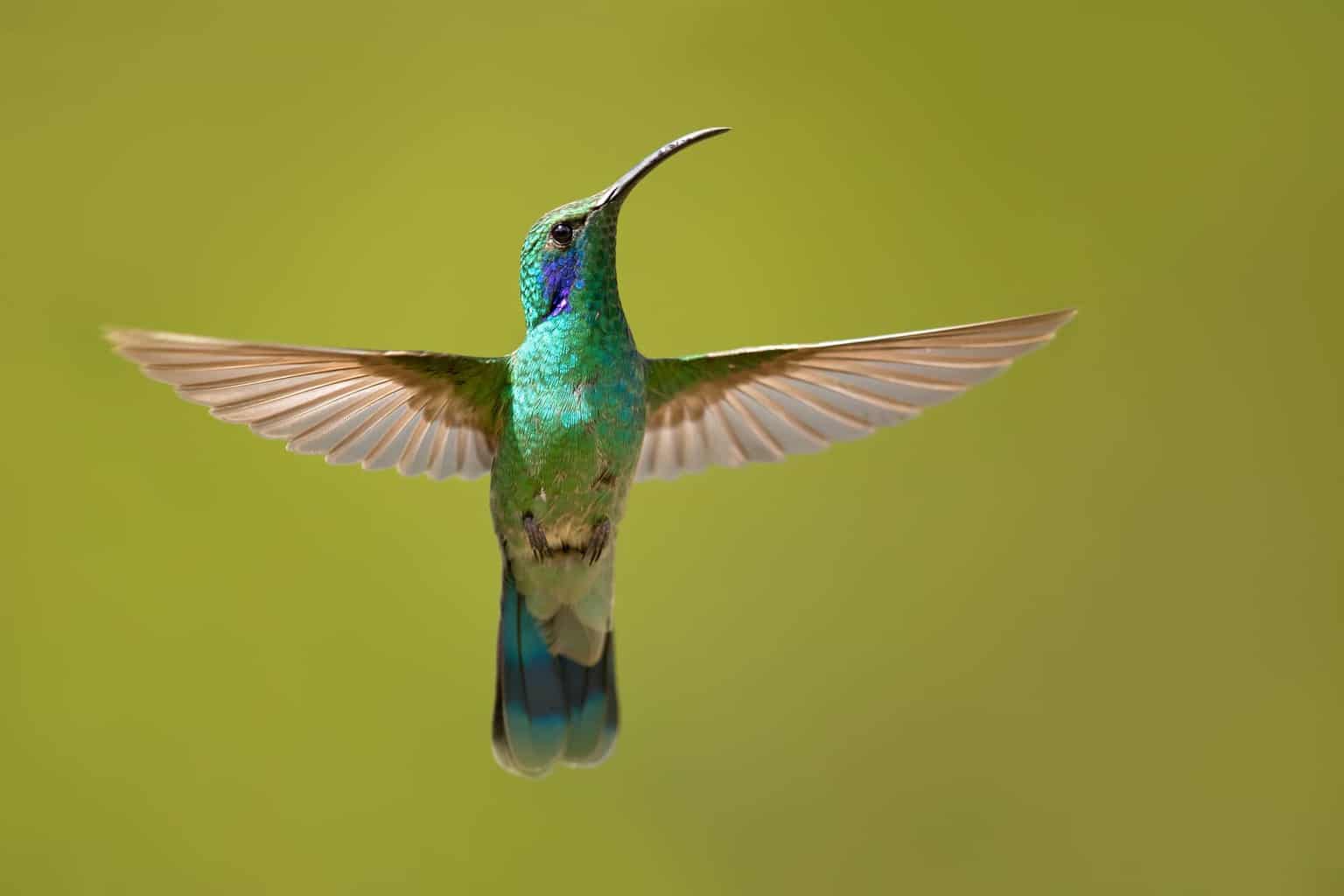
- Scientific Name: Colibri thalassinus
- Length: 3.8–4.7 inches
- Weight: 0.2–0.3 ounces
- Wingspan: 4–5 inches
Mexican Violetears aren’t common birds in Iowa, so finding them may be a bit challenging. However, they’re known for their occasional visits to the state, so you may get lucky.
Violetears have green bodies with blue feathers on their necks. Their bodies are a bit glossy, giving them a magnificent look under the sunlight.
They mostly stay around forest edges and clearings, but they have a nomadic behavior. They don’t have fixed habitats, so you can catch them anywhere.
Mexican Violetears are often undermined by larger hummingbird species. You may think it’s because of their small bodies, but it’s actually because they prefer solidarity.
When they stay alone, they become more susceptible to getting hunted, and these types of birds absolutely love solidarity.
They may be found in loose groups when there’s a lot of food in one place. Other than that, they’re seen alone.
Lewis’s Woodpecker

- Scientific Name: Melanerpes lewis
- Length: 10.2–11.0 inches
- Weight: 3.1–4.9 ounces
- Wingspan: 19.3–20.5 inches
Lewis’s Woodpecker may be included in both red and green bird lists. They have red underbellies and faces, but their backs and heads are dark green, so it’s obvious which color takes the cake here.
Despite being classified as woodpeckers, these birds seldom act like their species. Their flight is similar to that of a crow, and they forage like flycatchers.
They mostly stay on top of telephone wires or trees, looking for flying insects for food.
Lewis’s Woodpeckers are commonly found in woodlands, pine forests, and burned forests. Outside of their breeding season, they’ll wander across a variety of places, looking for nuts and insects to catch.
If you want to attract a Lewis’s Woodpecker to your backyard, you’ll have to provide a dead tree. The woodpeckers will come in an instant, and they’ll be a sight to behold!
Orange Birds in Iowa
American Robin

- Scientific Name: Turdus migratorius
- Length: 9.1–11.0 inches
- Weight: 2.5–3 ounces
- Wingspan: 12–16 inches
American Robins are among the most common species in North America. You’ve likely seen a robin pulling a worm out of the ground before, even if you don’t remember it.
The robins are best known for their orange breasts and pale gray wings. They have a loud, cheery song that helps people identify them from a distance, and they’re more abundant at the end of winter.
Robins are city birds, which means they’re usually found around the city streets and populated areas. However, you can also find them in the wilderness and near mountain forests.
If you want to attract American robins to your bird feeder, you can lay some raisins, fruits, seeds, crushed peanuts, and sunflower seeds.
You can also install a nest box to attract two breeding robins. Before doing that, make sure to check the breeding season of American robins in your area.
Vermilion Flycatcher
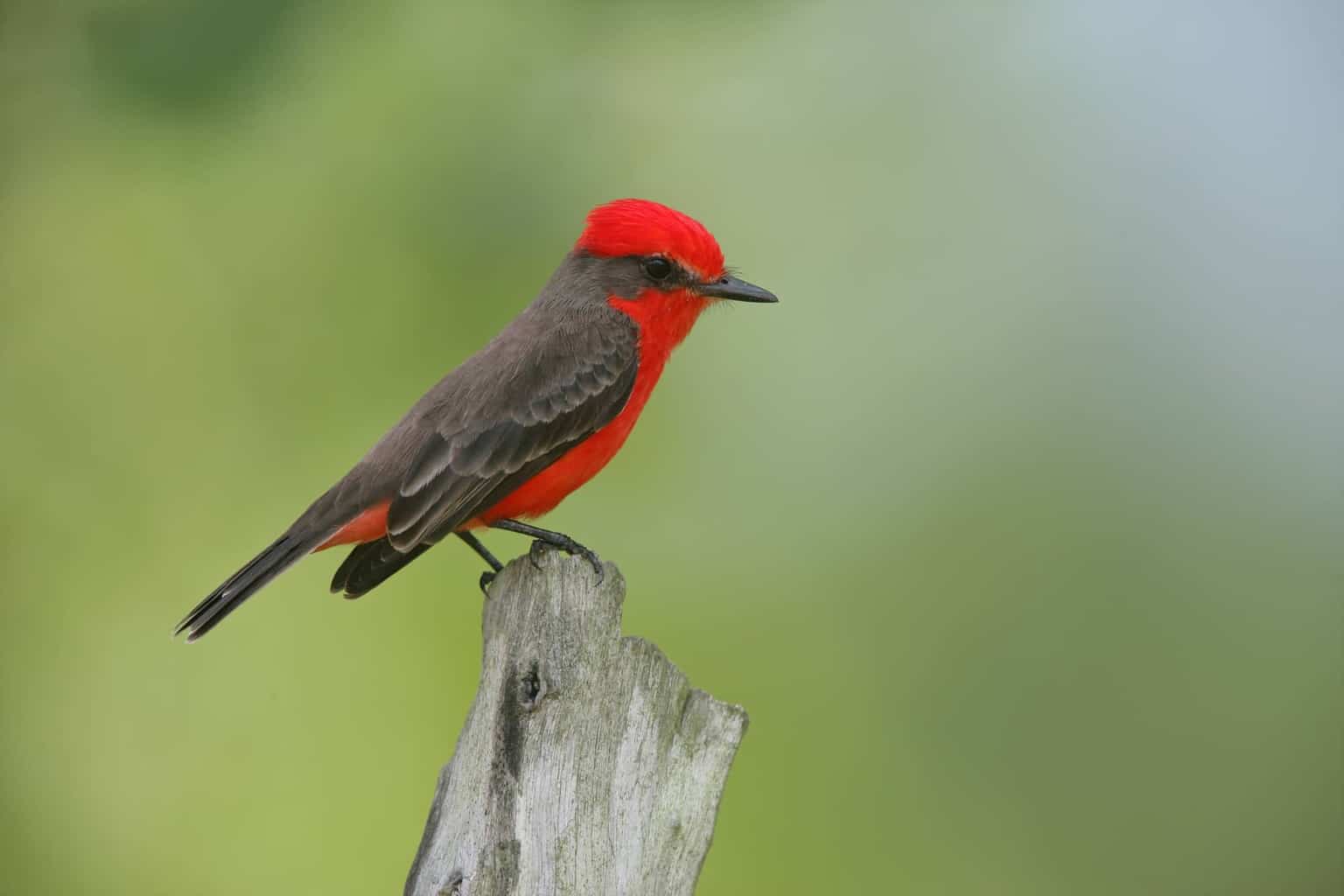
- Scientific Name: Pyrocephalus obscurus
- Length: 5.1–5.5 inches
- Weight: 0.3–0.5 ounces
- Wingspan: 9.4–9.8 inches
Vermilion Flycatchers are either orange or red, making them one of the easiest birds to identify due to their bright coloration.
The adult males are bright red with crests and brownish-gray wings. Meanwhile, the adult females have orange bellies and gray wings and heads. They don’t have a crest, unlike the males.
These colorful birds spend most of their time perched up on fence lines, telephone lines, and shrubs. They wait for flying insects to catch them, living up to their name.
They’re mostly in exposed areas, so it’s relatively easy to find them. If you want to attract them to your feeder, just lay some suet, seeds, and crushed peanuts. Bear in mind that they’re larger than robins, though, so make sure your feeder will fit them.
Bullock’s Oriole

- Scientific Name: Icterus bullockii
- Length: 6.7–7.5 inches
- Weight: 1.0–1.5 ounces
- Wingspan: 12–13 inches
The males and females of Bullock’s Oriole are quite similar, except the females have a paler coloration overall. Other than that, they both have orange bellies, chests, and faces. The top of their heads and wings are either black or gray.
The orange-colored Orioles mostly forage in branches of shrubs and trees. They spend a lot of time on trees, looking for caterpillars or fruit nectar.
The Orioles have agile bodies, making their flight faster than birds of the same size. Plus, they’re active and have some weird habits. You may run across one Oriole hanging upside down to reach a food source or prey.
These birds are mostly found in city parks, oak woodlands, along streams in open woodlands, and orchards. They don’t visit bird feeders, so it’s better to search for them in these places.
Yellow Birds in Iowa
American Goldfinch

- Scientific Name: Spinus tristis
- Length: 4.3–5.5 inches
- Weight: 0.39–0.71 ounces
- Wingspan: 7.5–8.7 inches
American Goldfinches are best known for their bright yellow bodies and black foreheads. The females are a bit paler, but both genders have yellow coloration nevertheless.
The goldfinches have a fascinating flying style; you’ll see these acrobatic birds bouncing up and down, with their wings spread high behind them. They also show some flapping moves in short bursts.
American Goldfinches feed on backyard feeders a lot. You may attract them by offering some thistles and seeds. In the summer, they feed on insects too, and there are plenty of those in backyards, anyway.
If you want to find goldfinches, try to look for them in clearings and weedy areas. Look for any planted thistle, and you’ll find them there.
Yellow-Throated Warbler

- Scientific Name: Setophaga dominica
- Length: 5.1–5.5 inches
- Weight: 0.3–0.4 ounces
- Wingspan: 8–8.3 inches
Yellow-throated Warblers are the most sought-after warblers in Iowa because of their bright yellow feathers. They arrive in the state in April, precisely in the second week. Merely two weeks later, they’ll be harder to find because large populations of them will have already left.
The males and females of Yellow-throated Warblers are quite similar, except the males have a sharp black mask over their eyes. Other than that, they both have gray bodies and yellow necks. You can easily identify them with their sharp, tall bills.
You can find these warblers in dark forests of pine, woodlands, and near swamps. They spend most of their time hopping on tree branches and looking for food in crevices and cracks.
These birds don’t come to feeders frequently. However, you can get lucky if you lay out some seeds and raisins for them. Target the second week of April, and you may find one roaming around your backyard.
Dickcissel
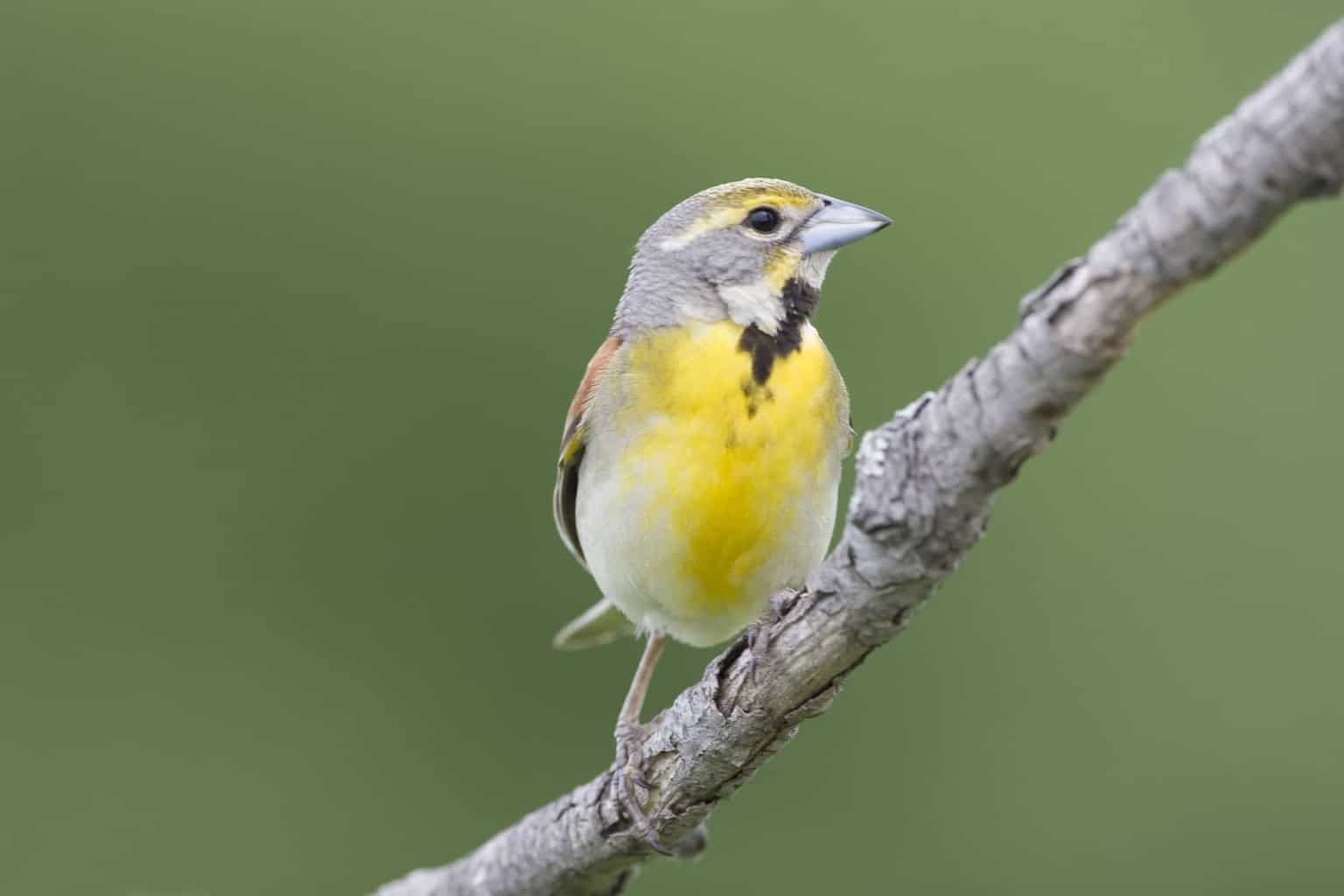
- Scientific Name: Spiza americana
- Length: 5.5–6.3 inches
- Weight: 0.9–1.4 ounces
- Wingspan: 9.8–10.2 inches
Dickcissels may not be easy to identify because they look like a lot of other breeds, like Meadowlarks, for example. You can identify them by their chest area; they have a black V with a bigger vivid yellow V underneath it, and their bellies are white.
The females don’t have the same V, so they may be harder to identify.
Dickcissels are called that way because of their call; it sounds a bit like Dick, Dick, sz, sizzle, sizzle.
These birds’ populations are growing lower in the Midwest, but they’re quite fine in Iowa, thanks to the Conservation Reserve Program.
Your best chance of seeing them is at prairies, pastures, roadsides, or hayfields. Go to any tall grassland area, and you’ll find them. They stay for the whole year, too, so you don’t have a tight schedule to follow.
Other Birds To Watch For in Iowa
Black-Capped Chickadee
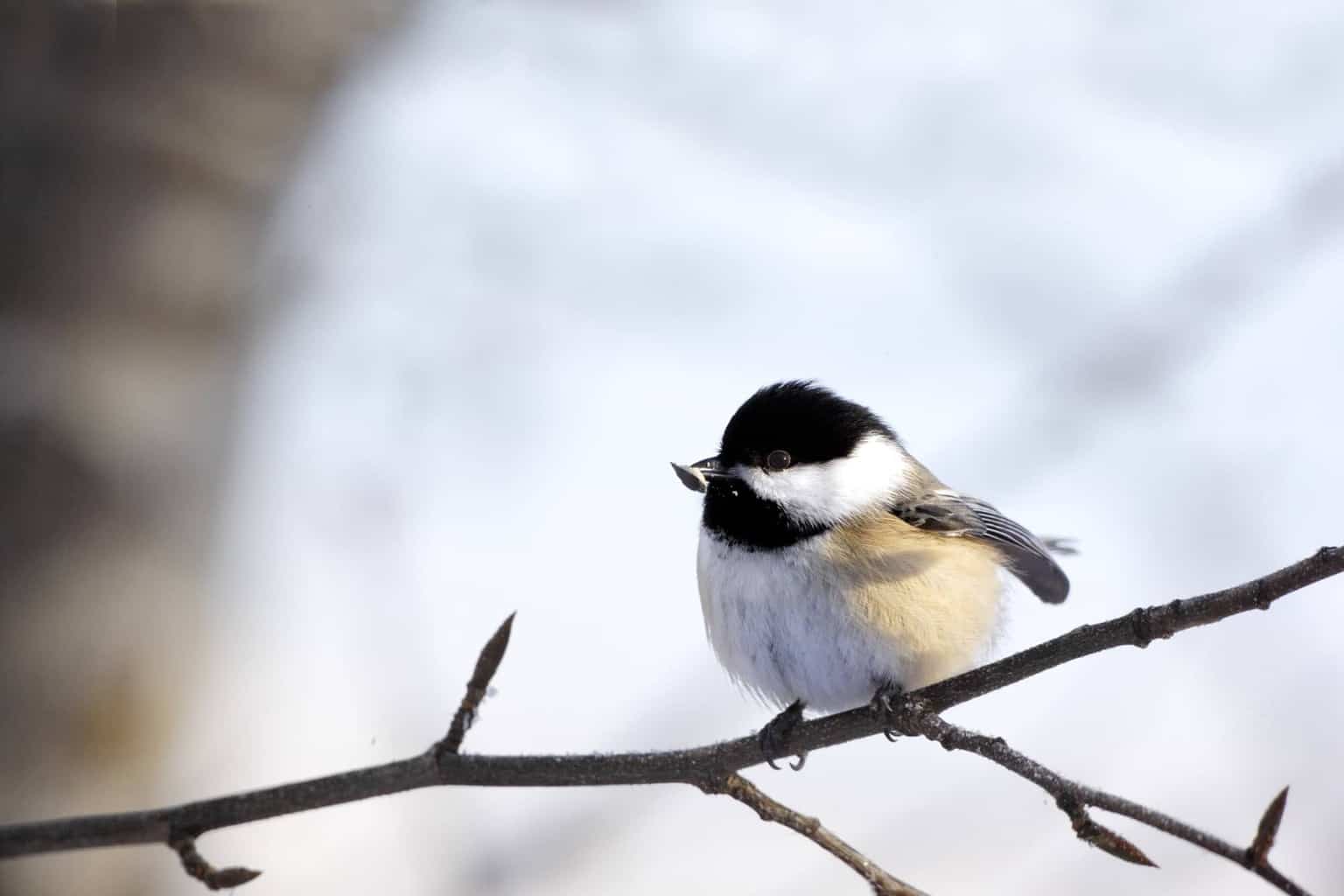
- Scientific Name: Poecile atricapillus
- Length: 4.7–5.9 inches
- Weight: 0.3–0.5 ounces
- Wingspan: 6.3–8.3 inches
Black-capped Chickadees are adorable, with their stocky frame and black head, and black body. Their coloration is quite unique, consisting mainly of gray wings, white underbellies, and black caps. The black on their heads extends below their eyes, making them look small and unnoticeable.
These birds have short necks and large heads, making their body look a bit funny, matching the shape of a ball.
The chickadees rarely visit feeders; your chance of catching them is better in their habitats. If they visit your feeder, they’ll take the food and go eat it somewhere. else
They mainly stay in flocks, and they’re somewhat acrobatic when flying. If you pass by a flying flock, you’ll see them fluctuating up and down, with their wings open in a beautiful circular shape.
If you want to find chickadees, look for them near woody shrubs and particular types of trees. They’ll also be at parks and residential neighborhoods. They mostly nest in alder and birch trees.
American Crow

- Scientific Name: Corvus brachyrhynchos
- Length: 16–21 inches
- Weight: 11–21 ounces
- Wingspan: 33–39 inches
The American Crow is one of the most common birds in the US. It looks pretty much like most species of crows, but you may be able to identify it with its straight bill and squared tail.
Plus, it’s larger than a raven and has a matte body, as opposed to the raven’s glossy one.
American Crows are known for their high intelligence level. They’re pretty much everywhere, from roadsides and residential areas to open woods and prairies. Your chances of catching them in Iowa are pretty high.
The black Crows feed on insects, worms, fruits, and seeds. They also steal other birds’ chicks and feed on them.
They don’t visit feeders frequently, but you can lay out some peanuts in an open space and wait for them.
Mourning Dove

- Scientific Name: Zenaida macroura
- Length: 11–12 inches
- Weight: 4–6 ounces
- Wingspan: 17–17.7 inches
Despite their gloomy name, Mourning Doves are quite pretty with their tan plumage and dark spots all over their wings. They mostly stay on telephone lines or forage on the ground.
Mourning Doves only visit platform bird feeders because they prefer to stay in open spaces. If you want to attract them, put out some millet, and they’ll pay a visit.
They also spend a lot of their time in dense shrubs. If you have those in your garden, you’ll come across a lot of doves.
In Iowa, Mourning Doves are abundant in all 99 counties, so finding them should be an easy mission. Their highest numbers are in the Loess Hills.
Conclusion
Although Iowa doesn’t have a lot of forests, it houses some of the most beautiful bird species in North America. If you go on birdwatching trips frequently, you’ll likely come across a lot of these species.
Look for Bird Jays and Northern Cardinals in particular. Most birdwatchers agree seeing them up close is a pleasant and fulfilling experience.

